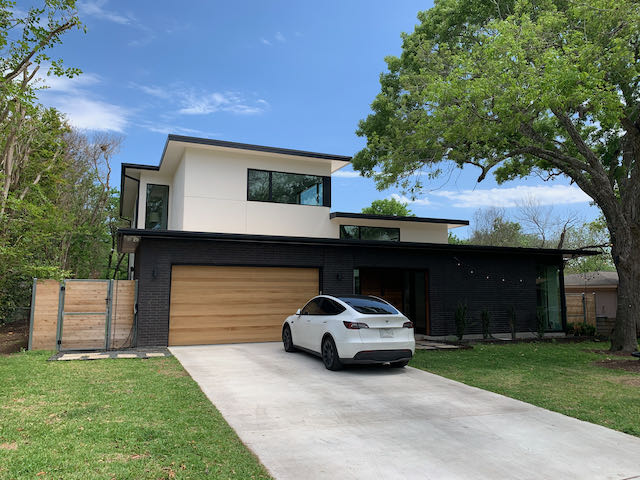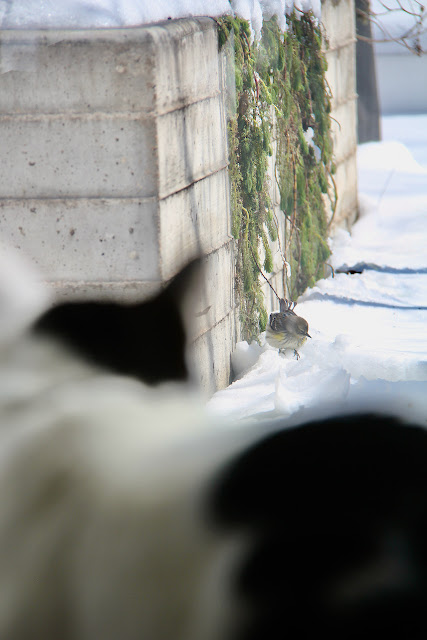Allandale is a surprisingly neglected part of Austin as far as redevelopment has gone in this town. South Austin and East Austin have been radically changed (especially East Austin) with redevelopment. This is probably because those parts of town are hipper with South Congress and the urban and arty vibes of East Austin. But with property costs off the hook in those areas and Elon Musk (and other Californians) moving to town, the scraping and building is, for better or worse, coming to Allandale. For a bit, besides the occasional Modern like ours, we were mostly getting suburban yawners that would not look out of place in Pflugerville. As property prices increased, we started to see custom transitionals appear, such as the farmhouse moderns and the it-only-takes-us-four-months-to-build contemporaries by Paradisa. I predicted that the cost of property would reach the point where we'd see the semi-custom fly-by-nighters get priced out by high-end custom builds. We may be there.
At present, scrapes (houses that will clearly be bulldozed for new construction) are going for about $600,000. That means, ideally, someone "should" build a $1.2 million house on that lot (the rule of thumb for financing is to spend 2X the lot price on construction). That is a $1.8 million home (and that ain't cheap). If that seems crazy, note that the transitionals in our 'hood are now going for north of $1.4 million. Our house is probably in that territory as well, meaning that we've doubled our money over the past seven years. Cray-cray.
What that means for new construction is that it's getting fancier, customized, and far more architecturally interesting, which is making our strolls through the neighborhood far more fun. Unfortunately, it's also raising our property taxes, but that's another post.
Some interesting places that are popping up include this place on Geraghty. I know there's going to be some crank who says "You're invading people's privacy by posting this stuff!" (1) This is all public information, so go procreate yourself. (2) As a concession, I'll only post streets instead of full addresses no names (but I'll name architects). (3) I'll probably only post stuff I like so as not to insult future neighbors with, imho, poor or uninspired designs. Furthermore, gems are not gems if everyone is a gem. Variety is the spice of architecture, so I actually welcome the variety of designs.
On with the show!
Designed by Winchester Architects out of Bryan, Texas, this is a cool MCM-inspired place. There is a LOT of steel in this house.
We're speculating that there a lot of steel because of the insane price of wood, but I think this is design-driven rather than economics-driven. At 3,151 square feet, this 4/4.5 is pretty sweet. The build for the house proper is listed at a value of $275,000 which is, pardon my French, bullshit ($87 a square-foot)! As we will see, reported low build cost is not unique to this property, so I'm not sure what the game is here... The number is provided for construction in the floodplain, so it seems an accurate number would be appropriate?
#oops #spellcheck #CoA
This is a decent (and I assume affordable?) Modern over on Cary Drive designed by Don Harris. This house has 3,090 square-feet for its 4/4 with construction for the primary structure valued at $300,000 ($97 per square foot). That pool is going to be nice this summer! I'm aesthetically partial to flat roofs; a big benefit is the reduction of height, resulting in houses with a better scale for the neighborhood even at two stories.
There's been quite a bit of construction on Cary, including this 3,502 square-feet cubist-delight (no primary structure flood cost info provided) with six bedrooms and 6.5 baths (including the detached guest suite).
This place is also on Cary and is owned (and reworked) by the builder who built the black farmhouse mod down the street from us, the best farmhouse in the 'hood imho. Really like what they did with this remodel, and the landscaping is fantastic. The big wooden panels on the left open up to a partially open-air garage, a nice way to integrate a front-facing garage into a design without having the expected form dominate the facade.
Another place on Geraghty is looking quite impressive nestled around a protected oak tree. This house, designed by Cornerstone Architects, has 3,817 square-feet, 5 bedrooms and 5.5 baths (including the casita), with no cost info provided. Interestingly, part of the second floor is clad in Corten Steel, which is going to rust (by design) but also run down the first-story roof, over the eaves, and onto the patio. Not sure what the thinking is there. The original design shows board-and-batt, so maybe this was a spur-of-the moment decision? Corten is awesome, but you have to think about the bleed...
Finally, I'll leave you with a Steve Zagorsky over on Bullard that may be a portent of things to come in Allandale. I really like Zagorsky's stuff since he's clearly influenced by early Modernism. In fact, I'm proud that when I saw this house under construction, I was able to correctly identify him as the architect.
There are several interesting things about this project. Interesting Thing No. 1 is that the lot probably cost the owners around a million (at least that's what the property was valued on the tax rolls before the dozer rolled). And they scraped it. That's a new high, as far as I know, for a purchase-n-scrape in Allandale. The lot backs up to Shoal Creek, which makes it extra-special (although you have to worry about flooding and restrictions on building due to that flooding). At that price point for a lot and using our rule of thumb, they "need" to build a $2 million house there to money out.
That leads us to Interesting Thing No. 2, which is the size and scale of this house: it is freakin' HUGE and horribly out of scale with the rest of the street. It has 5,282 square feet, 6 bedrooms, and 5.5 baths. The job is valued at $550,000 ($104 per square foot), which is, again, bullshit. With custom construction these days starting at $400 a square-foot, we are, again, looking at a $2 million build. The Bride is judging it harshly for its scale, but me not so much. Sure, it is (as I said) HORRIBLY out of scale, but--like it or not--this is the future of the street, if not Allandale as a whole. I also think that the scale is, in part, due to the floodplain and requirements not to increase flood potential. Then again, this is a massive house square-footage wise on any lot in the neighborhood.
Interesting Thing No. 3 is that the property is, in large part, in the floodplain. Since its in the plain of floods, it received floodplain information, including elevations that show the 25-year floodplain at 654.11 feet above mean sea level, the 100-year at 655.06 feet, and the 500-year at 656.56. Floodplain maps are currently being updated and, due to increased rainfall intensity, most likely due to climate change, the current 500-year floodplain will become the 100-year floodplain. So I hope they built to at least the 500-year level (turns out they're building to 659 feet: good move).
And finally, Interesting Thing No. 4 is that the original design, aesthetically (by my eyes) was OK but not inspired. Something prompted a reworking of the exterior that is far better than the contemporary facade below.

There's more (oh so much more!) to show about lots under construction in the hood, but we'll leave it at that for now.
























































